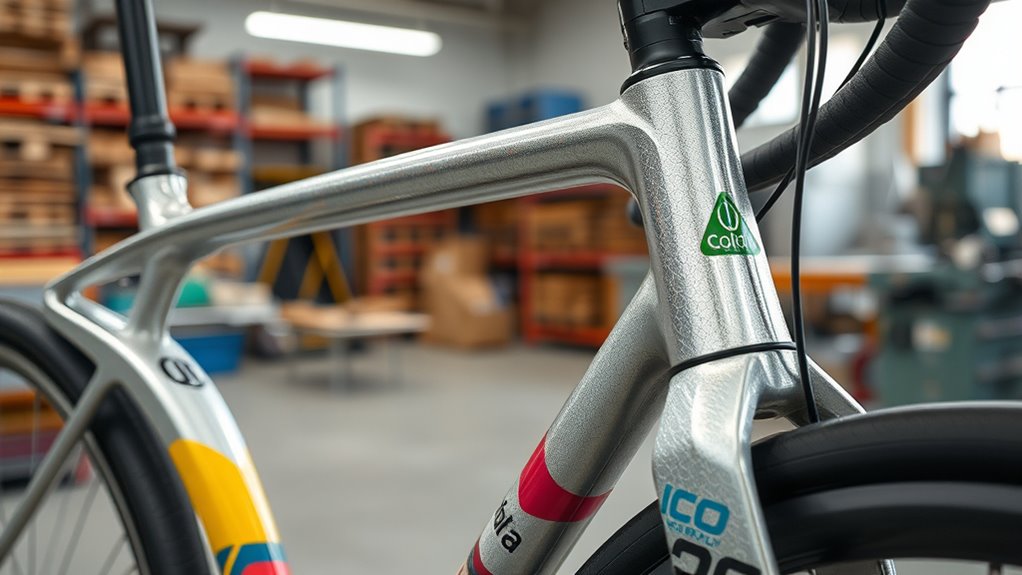Recycled materials like plastics, aluminum, and carbon fiber are revolutionizing bike manufacturing by making products more sustainable and eco-friendly. Companies are using recycled plastics to create lightweight, durable parts, while recycled aluminum frames reduce energy use and material waste. Advances in recyclable carbon fiber offer high performance with less environmental impact. Industry initiatives support a circular economy, and future legislation encourages more eco-conscious designs. To discover how these innovations are shaping the future of bikes, keep exploring further.
Key Takeaways
- Recycled plastics and aluminum are widely used in bike frames and components to reduce raw material consumption and environmental impact.
- Innovative recycled carbon fiber technologies enable high-performance, eco-friendly bike parts with recyclability and reduced waste.
- Industry initiatives promote circular economy principles by transforming waste like fishing nets and pre-consumer scraps into bike materials.
- Recycling technologies and standards support the development of fully recyclable composites, aligning with stricter sustainability regulations.
- Future legislation and repair policies will encourage manufacturers to adopt eco-friendly, recyclable materials in bike production.
The Benefits of Using Recycled Plastics in Bicycle Production

Using recycled plastics in bicycle production offers significant environmental and practical benefits. By replacing virgin plastics, you reduce raw material consumption and cut energy use by up to 75%, lowering the environmental impact. Incorporating recycled plastics into bicycle components boosts sustainability without sacrificing durability or performance, ensuring your bike remains reliable. These materials enable the creation of lightweight, corrosion-resistant, and maintenance-free parts that enhance rider experience and prolong bike life. Additionally, recycled plastics support circular economy initiatives, transforming waste like fishing nets and plastic granulates into functional bike components. This approach not only reduces pollution but also helps manufacturers meet strict environmental regulations, making recycled plastics a smart choice for eco-conscious bike production. Understanding the circular economy can further amplify the benefits of using recycled materials by promoting reuse and recycling practices throughout the product lifecycle. Moreover, utilizing recycled plastics aligns with sustainable manufacturing principles, which are increasingly important in today’s eco-aware market. Implementing advanced recycling technologies can further improve the quality and performance of recycled materials used in bicycles.
Advancements in Recyclable Carbon Fiber Technologies

Advancements in recyclable carbon fiber technologies are revolutionizing how high-performance composites are produced and reused in the bike industry. Recycled carbon fiber can now be integrated into carbon fiber composites through innovative closed-loop recycling methods like CompLam’s process, transforming waste into valuable recyclable materials. Thermoplastic CFRP offers a fully recyclable alternative to traditional thermoset epoxy composites, allowing components to be reheated and reshaped without compromising structural integrity. Major manufacturers are adopting these sustainable manufacturing practices, utilizing recycled fibers and resins to reduce environmental impact while maintaining high-performance standards. Innovations in recycling, including resin-free fibers, are boosting the circular economy in high-performance materials. Additionally, Vetted – Flat Iron Bike manufacturers are exploring these advancements to create more eco-friendly bicycles, emphasizing durability and strength while promoting sustainability for the future of bike manufacturing. Furthermore, integrating biodiversity-friendly materials in manufacturing processes can contribute to reducing ecological footprints and supporting conservation efforts. The development of recycling techniques is essential for expanding the use of recycled fibers across the entire supply chain, and ongoing research into fiber quality preservation is critical to ensuring recycled materials meet performance standards.
Incorporating Recycled Aluminium in Bike Frames and Components

Incorporating recycled aluminium into bike frames and components offers a sustainable alternative that doesn’t sacrifice performance. Recycled aluminium in bike frames, like those from Riese & Müller, can contain over 46% post-consumer recycled content, boosting sustainability without compromising strength. The aluminium recycling process uses only about 5% of the energy needed for primary aluminium production, markedly reducing environmental impact. Verified through test certificates, recycled aluminium maintains alloy quality equivalent to primary aluminium, ensuring durability and performance. Using recycled content in key components such as top and down tubes aligns with eco-friendly materials and responsible manufacturing practices. Recycling process plays a crucial role in maintaining the high quality standards required for bike components while promoting environmental sustainability. Additionally, advancements in recycling technology continue to improve the purity and properties of recycled aluminium, making it an increasingly viable choice for high-performance bicycle manufacturing. Incorporating sustainable practices into manufacturing processes further enhances the ecological benefits of using recycled materials. Furthermore, ongoing research into material durability ensures that recycled aluminium remains a reliable option for demanding cycling applications. Moreover, understanding material classification can help manufacturers optimize the use of recycled metals for specific bike components.
Challenges and Opportunities in Sustainable Composite Materials

While sustainable composite materials hold great promise for bike manufacturing, they also present significant challenges. Traditional thermoset carbon fiber composites are tough to recycle because they can’t be remelted or reshaped, leading to waste. However, advances in thermoplastic CFRP make fully recyclable composite components possible, allowing you to reheat and reshape parts without sacrificing strength. Recycling composite materials requires effective composite recycling technologies, which remain a manufacturing challenge due to high costs and scalability issues. Meanwhile, using recycled fibers from fishing nets or pre-consumer waste offers opportunities to develop environmentally friendly bicycle components. As you explore sustainable materials, balancing high performance with cost-effective recycling processes is key to creating innovative, eco-conscious bike frames and parts that meet industry standards and reduce environmental impact. Incorporating HEPA filter technology in manufacturing processes can also help improve material quality and sustainability standards. Additionally, ongoing research into recycling methods for composite materials aims to address these challenges and make sustainable bike manufacturing more feasible at scale, emphasizing the importance of material lifecycle management in advancing eco-friendly practices.
Industry Initiatives Promoting Circular Economy in Bicycle Manufacturing

Industry initiatives are actively driving the shift toward a circular economy in bicycle manufacturing by integrating recycled materials into production processes. Companies like igus are creating bikes with 92% recycled plastic, showcasing industry commitment to sustainability. Yamaha develops high-quality recycled polypropylene from pre-consumer waste for components, reducing reliance on virgin materials. Recycled aluminium frames, such as the Culture bike with over 46% recycled content, highlight the shift toward circular metal use. Industry collaborations, like Riese & Müller partnering with Hydro Aluminium, aim to increase recycled material percentages and attain ASI certification. Technological advancements, including closed-loop recycling and recycled fibers, support the progression to sustainable, circular manufacturing. Additionally, the adoption of recycling technologies enables more efficient reuse of materials throughout the supply chain. As the industry emphasizes cost-effective production methods, it further promotes the reuse of materials to enhance environmental responsibility. These initiatives illustrate how the industry is prioritizing materials reuse to promote cycling’s environmental responsibility and long-term sustainability.
Future Trends and Legislation Shaping Eco-Friendly Bicycle Materials

As governments and regulatory bodies tighten standards around sustainability, future legislation will substantially influence the materials used in bicycle manufacturing. Expect stricter recycling and reuse requirements, driven by legislation like the EU WEEE directive and UN plastic pollution resolutions. Costs for waste disposal, especially for non-recyclable materials like thermoset carbon fiber, will push manufacturers toward sustainable alternatives. Standards and certifications, such as ASI for recycled aluminum, will become mandatory, encouraging the use of recycled materials. Laws supporting the ‘right to repair’ and extended producer responsibility will demand bikes are designed for end-of-life recycling. Advances in recyclable composites, like thermoplastic CFRP, position the industry to meet future legislative demands, making eco-friendly, recyclable bicycle components more accessible and integrated into manufacturing processes.
Frequently Asked Questions
What Are the Eco Friendly Materials for Bikes?
You’re wondering about eco-friendly materials for bikes. You can choose recycled aluminum, which uses minimal energy, making your bike more sustainable. Thermoplastic carbon fiber composites are recyclable and maintain strength, while recycled plastics like fishing nets and landfilled waste are repurposed into bike parts. Biocomposites made from recycled fibers and plant-based resins also offer eco-friendly options, helping you reduce your environmental impact without sacrificing performance.
What Are the Materials Used in the Production Process of a Bicycle?
Imagine the journey of your bike, crafted from a mix of high-tech materials. You’ll find lightweight aluminum alloys, strong carbon fiber composites, durable steel, and sleek titanium, each chosen for their unique properties. Manufacturing involves processes like extrusion, molding, and additive techniques, blending virgin and recycled materials. These components come together to create a bike that’s not only high-performing but also increasingly eco-friendly, thanks to sustainable material choices and innovative production methods.
What Improvements Have Been Made to the Bicycle?
You’ll notice that bikes now feature significant improvements like lighter, stronger frames thanks to advanced manufacturing techniques such as 3D printing and automated fiber placement. These innovations enhance design flexibility and durability. Additionally, bikes incorporate eco-friendly materials like recycled plastics and aluminum with high recycled content, reducing environmental impact. Overall, these advancements make your ride more sustainable, efficient, and enjoyable while supporting eco-conscious manufacturing practices.
Can Carbon Fiber Bikes Be Recycled?
You’re wondering if carbon fiber bikes can be recycled. While traditional thermoset carbon fiber composites are hard to recycle because they don’t melt or reshape, newer thermoplastic composites can be heated and reshaped, making recycling easier. Innovations like closed-loop methods turn waste into reusable fibers. Although many bikes still end up in landfills, industry trends and regulations are pushing for more sustainable, recyclable carbon fiber bike solutions.
Conclusion
By embracing recycled materials, you become part of a cycle that transforms waste into innovation, much like a wheel turning endlessly forward. Every pedal stroke powered by eco-friendly components symbolizes progress toward a sustainable future. As you ride, you’re not just moving through space but through a revolution—where each recycled part fuels hope, resilience, and a cleaner planet. Keep riding the wave of change, and let your journey inspire others to join this ongoing circle of sustainability.
















